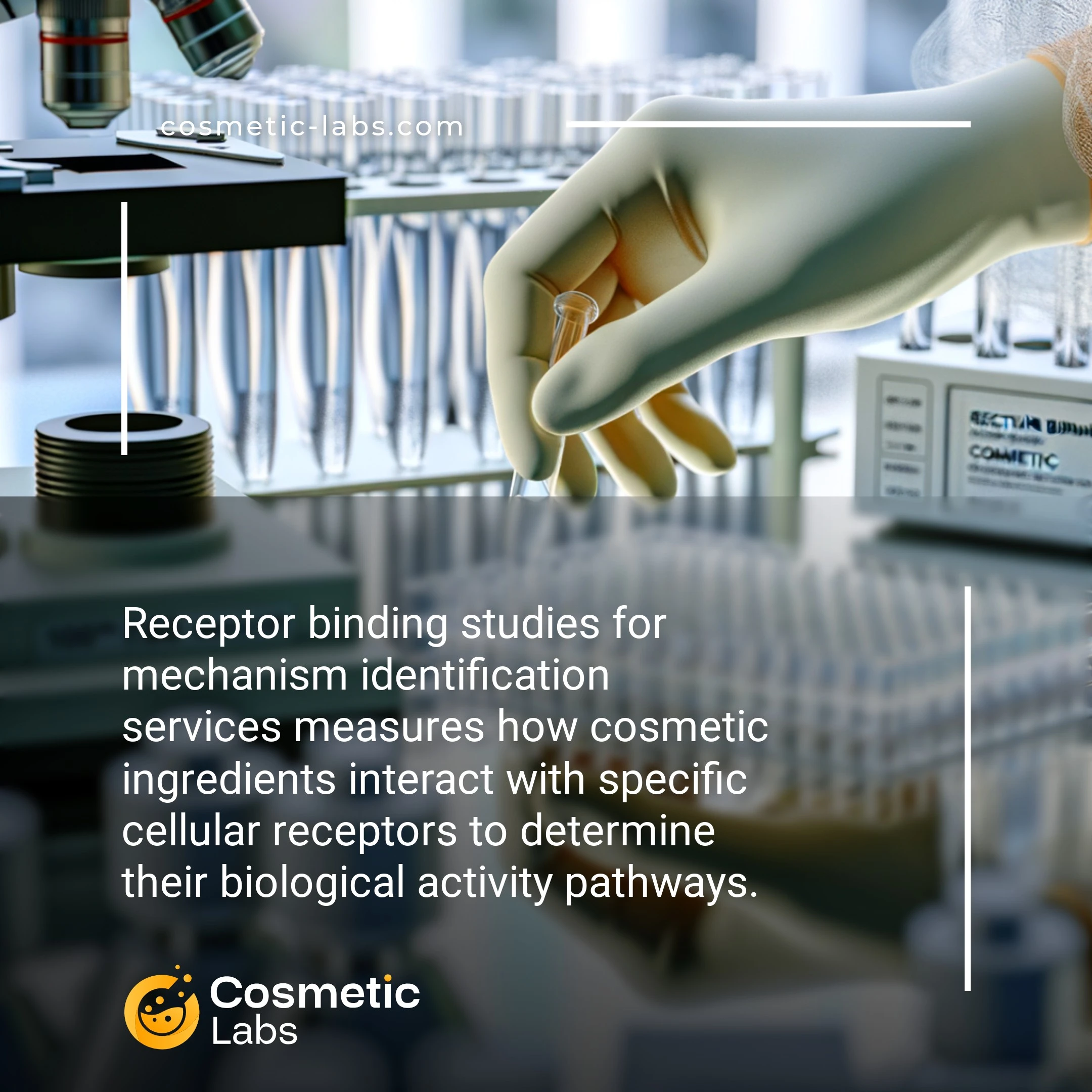Receptor Binding Studies for Cosmetic Ingredient Testing

What is Receptor binding studies?
Receptor binding studies for mechanism identification are laboratory tests that determine how cosmetic ingredients interact with specific cellular receptors to produce their effects. These studies use techniques like radioligand binding assays and fluorescence polarization to measure binding affinity and selectivity. Results reveal whether an anti-aging peptide targets collagen receptors or if a brightening compound blocks melanin production pathways, giving brands scientific proof of their product claims for regulatory submissions and marketing.
Why do you need this service?
Beauty brands use receptor binding assays to validate anti-aging claims when developing peptide serums and collagen-boosting formulations. These studies pinpoint exactly how active ingredients interact with skin cell receptors, delivering concrete proof for marketing claims and regulatory submissions. Labs on our platform help you demonstrate that your wrinkle-fighting complex actually binds to specific collagen receptors, turning formulation science into defensible product positioning.
Who provides Receptor binding studies services?
All cosmetic labs providing Receptor binding studies services
There is no company providing these services at the moment.
Receptor Binding Studies for Mechanism Identification Services
Receptor binding studies reveal how your cosmetic ingredients interact with specific cellular targets, providing the scientific foundation needed for mechanism of action research. These molecular-level investigations help brands understand exactly how their formulations work at the cellular level.
Binding Affinity Analysis and Target Identification
Labs use radioligand binding assays and fluorescence polarization techniques to measure how strongly your active ingredients bind to skin receptors. This data quantifies binding strength through IC50 values and dissociation constants.
Key binding parameters measured include:
- Receptor selectivity profiles across multiple targets
- Competitive binding with known ligands
- Kinetic association and dissociation rates
- Allosteric modulation effects
These studies help validate ingredient claims and support regulatory submissions with concrete molecular evidence.
Functional Assays and Downstream Signaling
Beyond basic binding, labs examine how receptor activation translates into cellular responses. Functional assays track second messenger systems, enzyme activation, and gene expression changes following receptor engagement.
Common functional endpoints include:
- cAMP/cGMP level measurements
- Calcium flux monitoring
- Protein phosphorylation cascades
- Transcriptional activity changes
This data connects molecular binding events to observable skin benefits, strengthening your product’s scientific story. Contact labs on our platform to discuss receptor binding studies tailored to your specific ingredients and target claims.
Practical Applications of Receptor Binding Studies for Mechanism Identification
Receptor binding studies for mechanism identification services provide beauty brands with concrete data about how their active ingredients interact with cellular targets, enabling evidence-based product positioning and regulatory compliance.
Anti-Aging Formula Development
Cosmetic labs use receptor binding assays to identify how peptides and botanical extracts interact with collagen synthesis pathways. These studies reveal binding affinity values (IC50 measurements) for key receptors like TGF-β and PDGF, which drive fibroblast activation. Labs typically screen 10-15 ingredient concentrations to establish dose-response curves within 2-3 weeks.
The data helps formulators optimize active concentrations and supports marketing claims about wrinkle reduction mechanisms. Brands receive detailed binding profiles that demonstrate specific receptor interactions rather than generic “anti-aging” benefits.
Skin Barrier Enhancement Research
Labs conduct receptor binding studies to understand how ceramides, fatty acids, and barrier-repair ingredients interact with peroxisome proliferator-activated receptors (PPARs). These nuclear receptors regulate lipid metabolism and skin barrier function through specific binding interactions.
Testing protocols measure binding displacement using radiolabeled ligands, providing quantitative data about ingredient efficacy. Results typically show binding constants ranging from 0.1-10 μM for effective barrier-repair compounds, giving brands scientific backing for moisturizing and protective product claims.
| Receptor Target | Typical Binding Range | Study Duration | Primary Application |
|---|---|---|---|
| TGF-β Receptor | 0.5-5 μM | 14-21 days | Collagen synthesis, anti-aging |
| PPAR-γ | 0.1-2 μM | 10-14 days | Barrier repair, moisturization |
| Melanocortin-1 | 1-10 μM | 7-10 days | Pigmentation control |
| Androgen Receptor | 0.2-3 μM | 14-18 days | Sebum regulation, acne treatment |
Ready to validate your ingredient mechanisms with receptor binding studies? Contact cosmetic labs on our platform to discuss your specific testing requirements and timeline.
